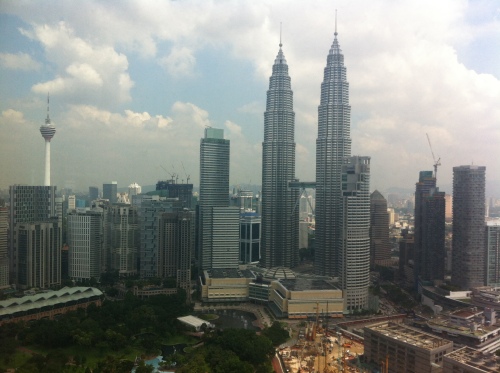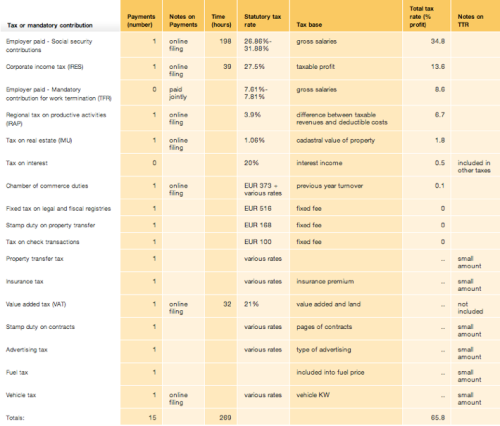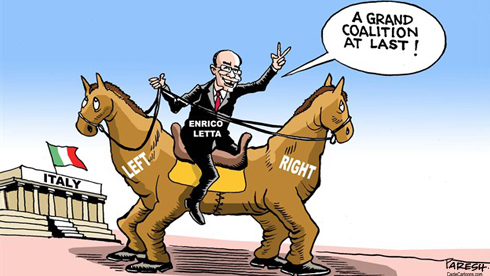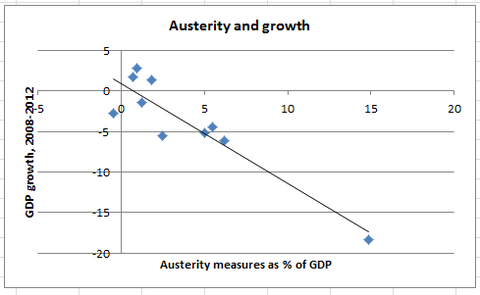The Political Courage on the Migration Compact Will Determine the Future of Europe
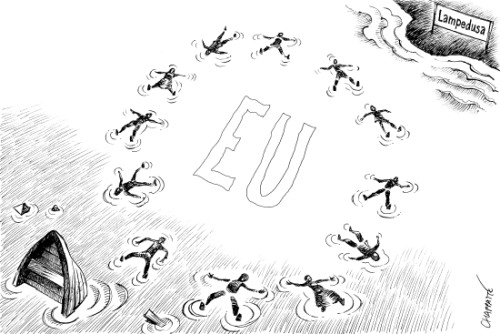
Image Courtesy of Chappatte: http://www.globecartoon.com
Premise: we must not forget that when we talk about migration we are actually talking about thousands of human lives–innocent children, women and men–that get lost every year in the pursuit of a normal life. The humanitarian aspect of migration in the Mediterranean is dramatic and should by itself be sufficient to allow EU countries to take unprecedented measures to curb this tragic reality. This is definitely what should have already driven EU countries to put forward a long-term plan. The incapacity or political unwillingness from certain member states to come up with a solution has been, however, evident so far.
The issue of migration flows is the next imminent threat to the unity of the EU. Considering that the number of attempts to cross the Mediterranean multiply over the summer period, the crisis requires an immediate resolution.
It’s the time for a political turning point. The best way to demonstrate the relevance of the EU in face of Brexit is to push for a courageous Migration Compact à l’italienne rather than the watered-down version that came of out of the Commission.
If the EU comes out again with its renowned half-measures (at best) on the migration issue, it will be a further confirmation of its inability in decision-making, thereby reinforcing euroscepticism.
Immigration policies have played a crucial role on Brexit. The EU needs to show it is able to provide timely and courageous responses to those global challenges. This is the only way to demonstrate that “together we are stronger.” This may really be the last call to keep the EU together.
Political instability, wars, the spread of ISIS, climate change, failed states are all factors telling us that the magnitude of migration flows is not a contingency and we must expect such massive flows to be a constant for many years to come. In order to face such a long-term global challenge, the EU needs to show its unity.
Three main aspects are worth analyzing. The crux of the matter remains first and foremost political. There is a need to find a mechanism for co-responsibility with the other member States. This was the core message of the Italian proposition in the original text of the Migration Compact that called for a Eurobond, which would signal the shared responsibility in facing the crisis. Mario Giro, Italy’s Vice Minister of Foreign Affairs and International Cooperation, has recently stated that “Italy is not ideologically attached to the idea of Eurobonds” and that “alternative measures are welcome” as long as the political message of mutual responsibility remains the same.
Second, the financial resources to be put on the table are the indicator of the political will to find a credible solution. The departure from Italy’s original Migration Compact is not a good sign. The New Migration Partnership Framework of the Commission replicates the same (ambiguous) “Investment Plan for Europe” scheme a.k.a Juncker Plan according to which an investment package of €60 billion would trigger and leverage (quite magically) investment in the “real economy” for €315 billion. The economic think tank Bruegel analyzed the Juncker Plan a year after the beginning of its implementation and noticed that: “since it got underway a year ago only €11.2 billion worth of projects have been approved, just over half of the target for the first year.”
It is, therefore, unclear how the New Migration Partnership Framework will actually benefit from “building on the experience of the successful Investment Plan for Europe.” In fact, the New Migration Partnership Framework announces resources for €3.1 billion for several African partners–against the €3 billion made available for Turkey alone in order to curb the contingency of the migration flows caused by the Syrian War–that are “expected to trigger total investments of up to €31 billion and the potential to increase to €62 billion.”
Vice Minister Giro is right in stressing the need of an holistic Europe-Africa agreement to create a win-win situation that focuses on investment in energy and infrastructure where European companies can play a key role as well as agri-business–a crucial area of development for the sustainable growth of the African continent and its security. In order to shape up a similar grand partnership, the real financial resources on the table have to be significantly increased.
The third important aspect of the departure from the Italian version of the Migration Compact is the re-emergence of the old-fashioned Western idea of providing financial resources with strings attached. African partners, instead, have to be empowered through co-ownership of the framework.
Imposing conditions to your counterpart is by definition not a partnership. Historically, this has been the approach included in the European aid policies. The “carrot and stick” approach evokes the paternalistic vision to provide funds in exchange of proof of performance–in this case the African partners’ ability to demonstrate to be able to curb the massive flows of migrants.
The effectiveness of the New Migration Partnership Framework is, however, extremely dubious when the mutual security of the EU and African counterparts is at stake. Moreover, it is not clear how long-term investment on strategic sectors such as energy and infrastructure could take place if the disbursement would be tied to periodic reviews.
The strongest answer in the aftermath of Brexit is implementing courageous policies instead of getting stuck with the usual techno-politics EU leaders got us used to so far. I hope the European leadership will surprise us with the necessary rush of pride and put the migration issue at the core of a new spirit of the EU.
All six foreign ministers of the founding members agreed on Saturday that Europe needs to do more to solve pressing issues like the migration crisis. The European Council that will take place tomorrow and Wednesday is the only golden opportunity to show the braveness that has been lacking to EU leaders for a long time now. It’s time to put your money where your mouth is.
Malaysia’s capital-intensive approach to become the next international education hub
Education tops once again Malaysia’s political and economic agenda. Prime Minister Najib Razak unveiled on October 10 the new federal budget for 2015, in which education receives the largest allocation equal to RM56.6 billion (USD 16.2 billion), or 26% of the overall budget.
Education is recognized as the cornerstone of Malaysia’s Economic Transformation Programme. As such, it has been identified as a National Key Economic Area, with the objective of making Malaysia an international education hub by attracting 200,000 international students by 2020. Already in 2011, the World Bank assessed that Malaysia’s public expenditure on primary and secondary education as a percentage of GDP, was slightly higher than OECD average (3.8% versus 3.4%). In the Asian context, Malaysia’s public spending on education was more than double that of other ASEAN countries (3.8% versus 1.8%), and 1.6% higher than the “Asian Tigers” (South Korea, Hong Kong, Taiwan, and Singapore).
Concerns over deteriorating performance despite enormous investment
Experts in the sector, however, are raising eyebrows over the decreasing quality of education offered as well as the expected return on investment of the 2015 budget for education. Concerns are rising due to Malaysia’s deteriorating performance in the PISA assessment. According to the latest report, Malaysia scored below OECD average and in some areas (science and reading) the country’s performance worsened compered the previous assessment.
Critics underlined that the policy embraced by the government is excessively investment-driven without paying the necessary attention to teachers’ training and development needs. The 1BestariNet project, for instance, has the objective to supply 4G broadband access to all 10,000 schools in the country and promote the use of e-learning techniques by supplying new technological equipment thereby cutting the ratio of student-device to 10:1. Budget 2015 records a RM200 million (USD 57.3 million) increase in “hardware” developments (infrastructure and ICT) but also a RM600 million (USD172 million) cut in “software” services, such as pre-service, in-service and leadership training of teachers. From 1999 to 2010, the Ministry has invested approximately RM6 billion on ICT infrastructure for schools. However, UNESCO states that there is still little evidence that the usage of this technology is actually facilitating creativity, problem solving, and critical thinking.
Risks and opportunities of aligning education to economic objectives
On the one hand, education lobbyists such as Parents Action Group for Education (PAGE) and public think tanks as the Penang Institute criticized the economic-oriented educational system that leaves little room for social objectives and equitable development of students. It appears that the adoption of latest technologies has little marginal impact on pupils in rural areas, where teachers do not receive the necessary training to reap the benefits of ICT infrastructure. On the other hand, the World Bank praises Malaysia for its effort in addressing the mismatch between education and market requirements, a gap responsible for leaving many graduates jobless. The presence of publicly funded high-tech parks – such as Kulim High-Tech Park, Senai Park, Technology Park Malaysia, Kuantan High-Tech Park – distributed on the whole national territory contribute to shape a conducive environment by leveraging R&D potential and profitability for innovative companies.
The internationalization of education
Malaysia is taking advantage of the rising global student mobility. According to UNESCO, the country is the 11th most preferred study destination worldwide and hosts students from approximately 100 countries. Due to steer competition from mid-value manufacturers such as India and China, Malaysia is investing heavily on education as the key variable to accomplish its economic transformation. This move did not go unnoticed to many MNCs that are picking Kuala Lumpur as their regional HQ because of the availability of high-skilled human capital. Private institutions and international schools have been mushrooming along with foreign universities setting branch campuses in Malaysia. EduCity, for instance, a project spearheaded by the federal government and State of Johor, is Malaysia’s first multi-campus education cluster. Ten international education institutions have signed up to set up local campuses in EduCity so far, of which two are secondary schools and the rest are higher learning institution. This provides foreigners with opportunities to send their children to internationally accredited institutions and places Malaysia in the right position to attract new talents from all around the world to fulfill its vision to become an international education hub.
Malaysia: The Gateway to ASEAN
Here you can download the latest report I contributed to realize on Malaysia. It was recently distributed with The Daily Telegraph.
Take a look at it or download it (it’s free) if you want to know more about Malaysia’s…
- Business environment
- FDI incentives
- Innovation and high-tech cities
- Telecommunications
- Regional economic corridors and related investment and business opportunities
- Education, human capital development, and the transition towards a “knowledge-based economy”
- The country’s global leadership in Islamic finance, a viable financial alternative for all
- Oil & Gas
- Tourism attractions
Comparative Politics Vol 2: Ease of Doing Business. Malaysia vs Italy
Malaysia ranks 6 in the World Bank’s Ease of Doing Business Report 2014.
One of the key variables to make sure to become the location of choice of foreign investors is the ease of doing business. As you can see, one of the indicators in the table above is “Paying Taxes.” So let’s take tax incentives and regulations for instance, as I’ve had the opportunity to interview the CEO of the Malaysian Inland Revenue Board, Tan Sri Shukor.
In Malaysia it is possible to file taxes online, through an e-filing system. The e-filing system not only guarantees efficiency for the government and companies in terms of cost and time savings but it also ensures fair treatment to the public (for instance you can get tax returns within 30 days).
Moreover, in line with the government strategy to develop strategic economic activities (e.g. biotechnology industries, operational headquarters, international procurement centers, regional distribution centers, real estate investment trusts, treasury management centers, 4 and 5 Star Hotels in Peninsular Malaysia, private and international schools, provider of industrial design services in Malaysia, child care centers and pre-school education), international investors allocating resources in specific geographical areas or sectors enjoy tax holidays and don’t have to pay income tax for a certain number of years. Dividends are tax-free and companies willing to re-invest in R&D in Malaysia may be eligible to double-deduction.
Companies that are recognized with the Pioneer Status are eligible to a tax exemption ranging from 70 to 100%. In alternative, another tax incentive is the Investment Tax Allowance (ITA) for projects that imply long-term large capital investments.
The government has created a conducive ecosystem for business to thrive and the private sector aligns profit-making with innovation and socio-economic development. All the ingredients are there to make Malaysia an economic case study of excellence.
Italy ranks 65, after all European countries except for Greece, Romania, Czech Republic, and Malta.
If we don’t want to get stuck in this recession for decades this is definitely an area that we must reform. We need to simplify procedures and digitalize systems. This is also a way to cut public spending. Let’s get rid of red-tapes and reduce excessive costs (e.g. notary fees); a good idea could be to create a one-stop center for opening up a business where you take care of all paperwork/procedures at the same place. Should there be a need to communicate with different offices, this should be done internally and electronically.
Italy
Malaysia
Let’s compare the “Paying Taxes” indicator. Besides the fact that our tax rate is equal to 65.8% of profits, while in Malaysia is 36.3%; the time and labor tax and contributions are 2/3 times higher in Italy than the average in OECD countries and Malaysia.
In Italy it takes 269 hours per year to pay taxes against 175 as an average of OECD countries and 133 in Malaysia. Labor tax and contributions stand as high as 43.4% in Italy. It’s 23.1% in OECD countries and 15.6% in Malaysia. How can we expect our unemployment rate to go down? It’s simply impossible for many companies to hire more workers with these labor costs.
Italy
Malaysia
In order to be more competitive in the global market we need to increase significantly what here is referred to as “ease of doing business.” Regulations must be simplified; procedures must be streamlined; and systems must be digitalized. A reform in this direction will not only attract foreign investors, but also help us cutting public spending.
Oh, and I almost forgot… English…Because nobody else speaks Italian besides us.
Comparative Politics Vol 1: Education. Malaysia vs Italy – Politica Comparata Vol 1: Istruzione. Malesia vs Italia
I’ve been working on a socio-economic report in Malaysia for a few months now. Malaysia has accomplished an incredible development since its independence from the UK in 1957. From 1970 to 2010 the level of poverty has decreased from 49,3% to 3,8% (see p. 53). The various governments have significantly contributed to the economic transformation from an agricultural-based economy to an industrial one. The economic transformation is now set to make Malaysia a knowledge-based economy.
Political stability has been a crucial factor in the development of the long-term vision (from 1957 till today there have been 13 elections and 6 PMs whereas in Italy we’ve had 41 PMs’ alternations from 1946 up to today considering elections, cabinet re-shuffles, ‘coups within the Cabinet’ due to internal power struggles, and all sorts of other incomprehensible dynamics typical of Italian politics).
Here, the Government implements 5-year economic plans (i.e. the 10th Malaysia Plan currently underway). Back in 1991, the former Prime Minister Tun Mahathir launched his programme, Vision 2020, in order to make Malaysia a high-income country (the World Bank currently ranks Malaysia as an upper middle-income country).
There are many aspects that struck me positively. Above all the fact that everyone is conscious that in order to enjoy higher standards of living, the key variable to invest on is education. In 2011, the Government allocated 20.9% of the total public spending on education against 8.9% in Italy in 2010. If we look at other industrialized countries, the US allocated 12.7%; the UK 13.3; Norway 15.3%.
Universities here work hand in hand with industry in order to facilitate the access to the labor market. The Government supports financially all high-tech sectors that promote high-skilled labor and contribute to the economic transformation of the country. Due to steer competition from mid-value manufacturers such as India and China, Malaysia has taken a different direction by focusing on its comparative advantages (e.g. biotechnology considering the incredible biodiversity present in Malaysia) and investing heavily on technology and innovation (and by attracting FDI) thereby upgrading the value chain from mid to high-value added.
What about us? When is the last time we spoke about industrial policies (let alone five-year plans with investment targets, expected growth, and employment opportunities)? The complete absence of policies in our political debate is baffling as it is the lack of information and statistics. This is the website dedicated of the Economic Transformation Programme. It might be because I haven’t been in Italy for a while now, but I can’t remember anything like this in my country.
When are we going to understand that we have to focus on our comparative advantages? We have to realize that countries and entire regions that were excluded from the global market have now entered it as a consequence of globalization. The great majority of labor-intensive economic activities has moved where labor cost is lower. Trying to compete on a large scale on mid-value goods is a waste of time. So is seeking to get those jobs back. The inability to innovate and interpret the major socio-economic upheavals is what has brought Italy to a slow but steady decline.
How is it possible that in the country that boasts the highest number of UNESCO World Heritage sites (49) History of Arts – as a high-school discipline – gets cut down (or eliminated?) along with our permanent delegation to UNESCO? Of course I’m not saying that everyone should become either an artist or an art critic, but this is certainly an area that makes Italy unique in the world and that would create massive spin-offs in tourism and cultural economic activities.
Energy policy? Italy imports 79% of the energy it consumes. Considering how much we spend, we should be at the forefront in terms of R&D in renewable energy. Not only for strictly economic reasons, but also for strategic political ones (e.g. the consequences of Libya post-Gaddafi; and the Ukrainian conflict with Russia and the threat it poses in terms of gas supply to Europe). We could create, like in Malaysia, economic corridors in order to develop strategic economic areas with tax breaks, simplified regulations, and partnerships with universities in order to promote R&D and attract FDI, thereby creating high-skilled (and high-income) employment opportunities.
Lesson learned: the creation of a conducive ecosystem for innovative businesses starts from investments in education and R&D.
————————————————————————————————————————————————————————
Mi trovo da qualche mese in Malesia per sviluppare un report socio-economico sul Paese. La Malesia ha fatto passi da gigante dal 1957, anno della sua indipendenza dalla Gran Bretagna. Dal 1970 al 2010, il livello di povertà è stato ridotto dal 49,3% al 3,8% (vedi p.53). I Governi che si sono succeduti hanno contribuito significativamente alla trasformazione economica da una società agricola a industriale e ora “knowledge-based.”
La stabilità politica di cui gode la Malesia ha certamente contribuito allo sviluppo di una visione di lungo termine (dal ’57 ad oggi ci sono state 13 elezioni e 6 Primi Ministri contro i 41 avvicendamenti di Capi di Governo in Italia dal 1946 ad oggi, tra elezioni, colpi di palazzo, rimpasti, ribaltoni e altre denominazioni intraducibili e incomprensibili al resto del mondo).
Qui si fanno piani economico-industriali su base quinquennale (attualmente è in atto il 10th Malaysia Plan) e nel 1991 l’allora Primo Ministro Tun Mahathir lanciò il suo programma Vision 2020, una roadmap con lo scopo di far diventare la Malesia un Paese ad alto reddito (attualmente è classificato secondo la World Bank come upper middle-income).
Ci sono tantissimi aspetti che mi hanno colpito in maniera positiva (e spero di aver la possibilità di approfondirli in post futuri). Ma ciò che mi ha sorpreso maggiormente è che tutti sono consapevoli del fatto che per raggiungere migliori standard di vita, la variabile fondamentale su cui investire è l’istruzione. Nel 2011 in Malesia, la spesa pubblica verso l’educazione è stata del 20,9% del totale contro l’8,9% dell’Italia nel 2010. Se guardiamo altri Paesi industrializzati, gli USA investivano nel 2010 il 12,7%; la Gran Bretagna il 13,3%; la Norvegia il 15,3%.
Le università qui lavorano a strettissimo contatto con l’industria per favorire l’inserimento nel mercato del lavoro e il Governo sostiene finanziariamente tutti quei settori high-tech o che favoriscono lo sviluppo di high-skills che promuovono la trasformazione economica del Paese. Trovandosi a competere con colossi del settore manifatturiero di medio valore aggiunto (India e Cina), la Malesia ha intrapreso una direzione diversa, sfruttando i propri comparative advantages (per esempio nel settore della bio-technology data l’incredibile biodiversità) e investendo in maniera massiccia in tecnologia e innovazione (con incentivi per favorire l’entrata di investimenti stranieri diretti) che permetterà la trasformazione della produzione da medio ad alto valore aggiunto.
E noi? Da quanto non si sente parlare di politica industriale (figuriamoci di piani quinquennali con target specifici per quanto riguarda livelli di investimento, aspettativa di crescita e numero di posti di lavoro)? L’assenza di policies è a dir poco sconcertante nel nostro Paese e lo è altrettanto la mancanza di accesso a informazioni e statistiche. Questo è il sito che riguarda l’Economic Transformation Programme in atto in Malesia. Sarà che manco dall’Italia da un po’ ma non ho memoria di niente del genere. Soprattutto perchè manca la politica alla base.
E noi quando capiremo che per crescere economicamente dobbiamo concentrarci sui nostri comparative advantages? Dobbiamo renderci conto che la globalizzazione ha permesso l’entrata nel mercato globale di Paesi ed intere regioni che fino a poche decine di anni fa ne erano completamente escluse. Di conseguenza, gran parte dei lavori di tipo labor-intensive si sono spostati dove la manodopera costa una frazione di quella dei Paesi industrializzati. Cercare di competere in larga scala su questo territorio è tempo perso. Cercare di far “rientrare” quel tipo di posti di lavoro lo è altrettanto. La nostra incapacità di innovare, di interpretare gli sconvolgimenti globali a livello socio-economico ha portato al declino il nostro Paese.
Ma come si fa, nel Paese che vanta il più alto numero di siti Patrimonio dell’Umanità dell’UNESCO (49) a ridurre (o cancellare?) le ore di insegnamento di Storia dell’Arte e la rappresentanza permanente presso l’UNESCO? Questo non vuol dire (come molti bacchettoni italiani pensano) che “non possiamo mica tutti essere artisti o critici d’arte” ma di sicuro questo è uno di quei comparative advantages di cui sopra che rendono il nostro Paese unico al mondo e che creerebbero un immenso indotto tra turismo e cultura.
Politica energetica? L’Italia importa il 79% dell’energia che consuma. Noi dovremmo essere l’avanguardia della ricerca nel settore delle rinnovabili considerando quanto spendiamo. Non solo da punto di vista strettamente economico, ma anche politico, l’energia è strategica per non essere soggetti a shock esterni (si pensi alla Libia post Gheddafi e al conflitto russo-ucraino e le conseguenze sull’approvvigionamento del gas in tutt’Europa). Si potrebbero creare, come in Malesia, corridoi economici specializzati in settori strategici per l’economia con incentivi fiscali e regolamentari e partnership con le università per favorire la ricerca e lo sviluppo e attrarre investimenti esteri diretti creando così opportunità di lavoro di alta competenza (e alto reddito).
Morale della favola: la creazione di un ecosistema che favorisce lo sviluppo di attività economiche innovative parte da investimenti in educazione e ricerca e sviluppo
Innovation in Operations Assessment: Recent Developments in Measuring Progress in Conflict Environments
My publication with NATO Supreme Allied Commander of Transformation (SACT) finally published and downloadable here.
Transformational Activities in Operations Assessment
This first volume is on the concepts and processes used to measure the progress and results of military operations—called “Operations Assessment” in NATO. In the past two decades, NATO operations assessment has undergone substantial development, driven partly by the experience of the international missions in Bosnia, Kosovo, Iraq, and Afghanistan. This volume reviews recent practices, and suggests ways the process could be improved, including potential future innovations and capability developments.
This work was generated out of the large amount of worked conducted by ACT and partners on developing the NATO Operations Assessment Handbook, sections of the ACO Comprehensive Operations Planning Directive, and a training course for NATO School. This work was supported by a variety of analytical studies, concept development, and experimentation.
Shamelessly Treacherous
Newspapers announce another government crisis. This afternoon Berlusconi ordered to his Ministers to resign and they replied to their lord with a “Yes Sir.” Berlusconi knows the vote in the Senate will force him to relinquish his seat after his conviction for fiscal fraud this Summer. This is his last attempt to extort the President of the Republic a pardon, namely an act of clemency to forgive his crime; or to try to convince the Senate to save him by voting down the relinquishment of his seat.
To add insult to injury, we are witnessing for the umpteenth time Berlusconi and his political and news servants turning reality upside-down. For two months now, we’ve been listening over and over again that Berlusconi’s conviction was a product of Communist Judges trying to get rid of him with a sentence because of the inability of the Left to defeat him politically. Then- after Cassazione, the Court of third instance, confirmed the sentence of the Court of Appeal- we saw Berlusconi’s video message where he shamelessly stated in front of the whole country that he was innocent. Now MPs of Berlusconi’s party affirm that the reason they resigned is to avoid a tax increase that will occur starting from Tuesday. The tax increase, however, is a direct consequence of PdL’s (Berlusconi’s party) MPs refusal to sign a bill that would have avoided it yesterday.
It is unbelievable how these irresponsible MPs and their absolute master/owner mystify reality. Listening the Minister of Internal Affairs saying publicly that Berlusconi’s conviction and the subsequent relinquishment of his seat at the Senate is against the rule of law and that we now live in a judicial regime is outrageous. We are hostage of a certified criminal. In the rest of Western democracies parties such as PdL would not find place in the Parliament. Because of the subversive nature, PdL should be a mere extra-parliamentary force. In Italy, Berlusconi not only ruled the country for four (and a half, considering this grand coalition government with the Dems) times, but he also loves to define himself “the leader of the moderate conservatives.” Conservatives so moderate that do not want to comply with the rule of law; that pass bills ad personam to save Berlusconi from other trials; and let a country’s government collapse because they are unwilling and unable to survive without their political owner.
By the way, I started this blog during 2013 elections and it was clear since day one that this grand coalition would have been short-lived. In good faith or not, President Napolitano holds the majority of the burden of this failure. He accepted his second mandate as a result of a House of Cards-like Presidential elections with a clear idea in mind: facilitating the creation of a grand coalition. The whole political architecture built up by the President looked extremely weak and incapable of sorting out the huge Italian political, social, and economic challenges. This government should have simply been avoided. Berlusconi couldn’t wait to influence the daily political activity for his own interest and his MPs couldn’t wait to go along with their lord’s wishes. They have little, if any, political stature. They just repeat whatever the boss says, like parrots. No trace of deception in PdL, not even after the conviction. No sign of criticism to the line held by the supreme leader. Ever. Dems have no excuses. After twenty years, it’s no longer possible to believe in their good faith. Now that this new crisis erupted, they seem to fall from the sky. What the hell did you expect from Berlusconi?? He’s there only for his personal interest and he’s there with you as long as you save him. You don’t, you fall with him.
Informazione? Ma de che!
Questo è il livello dell’informazione in questo Paese. Servi di un sistema che fa comodo anche alla loro categoria. Questo è giornalismo? Negli altri Paesi, i giornalisti vengono criticati quando non pongono la “seconda domanda”, quella che incastra l’interlocutore. Da noi non c’è nemmeno l’ombra della prima! Far parlare a ruota libera e poi ripetere a pappagallo ciò che viene detto non equivale a fare informazione. Ma penso che questo sia anche il prodotto del nostro sistema educativo, dove anche durante gli studi universitari c’è una quasi totale mancanza di sviluppo di pensiero critico. Ore ed ore a prepararsi per esami orali dove viene chiesta la virgola del paragrafo X del capitolo Y che devi necessariamente ripetere a memoria.
Quando capiremo che fare informazione non significa avere talk show organizzati a mo’ di tribuna politica? Ognuno ripete le proprie posizioni, nessuna analisi viene prodotta, nessun contenuto approfondito. Il tutto serve solo a dare visibilità. I TG e i talk show sono il palcoscenico della propaganda. I politici vengono lasciati liberi di cantarsela e suonarsela per ore. Poi c’è il dovere di contraddittorio, dove per simil par condicio devono essere presenti, sempre in numero equo, rappresentanti di schieramenti opposti. Il tutto si traduce in un relativismo estremo dell’informazione: se si parla della sentenza di Berlusconi, naturalmente devono essere presenti una Santanché, un Sallusti, o un Belpietro che devono difendere a spada tratta il loro padrone. Come se di fronte ad una condanna definitiva ci fosse ancora bisogno di difendersi. Enough. Basta con questi talk show contenutisticamente vuoti. Che si pongano domande sulle policies (programmi, iniziative politiche) e non sulla politics (posizionamento dei partiti, alleanze, dibattiti tutti interni ai partiti) ad esperti e non alle solite facce (giornalisti a libro paga e politicanti) che non dicono mai nulla se non frasi retoriche e attacchi agli interlocutori.
Se i politici sono lì, sempre gli stessi, senza aver fatto crescere questo Paese negli ultimi vent’anni, la responsabilità è anche (e grande) di questi pseudo-giornalisti nostrani.
Krugman vs Alesina and the Italian Stalemate – Krugman contro Alesina e l’impasse italiano
What is the economic policy of the new Italian government? I bet no one can answer this question. On the one hand, the Democratic Party (PD)-or at least some of the ministers- emphasize the importance of cutting taxes on the labor market in order to boost employment. On the other hand, B (that just stands for Berlusconi since it’s hard to believe the existence of a structural party behind him) is obsessed with the repeal of IMU (a tax introduced by Monti on real estate). The problem is that PD and B are sitting at the same table, the Government. Both, however, stress the importance of maintaining the promises made to the EU (i.e. keeping the budget in order, whatever it takes) but at the same time say we need more investments to shake up the real economy.
Well, guess what? The two policies are mutually exclusive, especially in times of crisis. We either expand spending or we cut it. We either choose Keynesian economics or we go for Austerity. This choice mirrors the debate going on between Paul Krugman and Alberto Alesina, the first being of course the Keynesian and the second the Austerian from Bocconi. Krugman criticizes Alesina and Ardagna’s paper arguing that there is no evidence that spending cuts lead to economic expansion. In the Euro area, indeed, austerity has produced the situation in the graph below:
Alesina, in turn, replied Krugman saying “My paper has never claimed that every fiscal adjustment is expansionary. It just claimed that there have been examples in which some well-designed policy packages, based on spending cuts and other measures, have been associated with a positive impact on the economy.”
As I already pointed out in my previous post, the bottom line stays the same: it’s the boom, not the slump the right time for austerity. We all know how badly Italian governments have blown up taxpayers money for the past 30 years or more, and how much money ends up in corruption. I do believe there are sectors where spending must be cut (one example above all, eliminating provinces, a useless administrative layer that sucks money and makes our infamous bureaucratic system even slower).
Yet, do we really think that lying off thousands of people right now will help boosting our economy and keep our budget in order? With an unemployment rate at 11,5% and a big credit crunch, our priority is creating employment and this is why we need more spending now. The US went that way and they are getting out of this mess. We, in Europe, are falling even deeper into it.
So what is the incumbent government doing for our economy? Absolutely nothing. First of all because of its inherent weakness (Left and Right can hardly agree on what the recipe should be, assuming they have any idea about what should be done at all). Second, because we don’t have the guts (and the credibility, since the rest of Europe laughs at us seeing Berlusconi once again) to renegotiate the Fiscal Compact within the EU.
The priorities of our politicians are clearly different. While PD proposes to ban “movements” from running for the next elections (clearly targeting the Five Stars Movement), the Five Stars can’t discuss anything else than how much their own elected MPs should spend for lunch or dinner; B, of course, has a more compelling priority in times of crisis and proposes to halve the term of imprisonment for the people charged with association with the Mafia. This will definitely help restore our economy.
——————————————————————————————————————————————————————————————————————–
Qual è la politica economica del governo Italiano? Scommetto che nessuno abbia una risposta a questa domanda. Da un lato, il PD⎯o almeno alcuni ministri⎯mettono al centro la questione della riduzione delle tasse sul lavoro al fine di sostenere l’occupazione. Dall’altro lato, B (perchè tanto è inutile di parlare di PDL dato che non c’è alcuna struttura partitica dietro di lui) è ossessionato con l’abolizione dell’IMU. Il problema è che PD e B sono seduti allo stesso tavolo, il Governo. Entrambi, tuttavia, sottolineano l’importanza di mantenere le promesse fatte all’UE (tenere i conti in ordine, a qualsiasi costo) ma allo stesso tempo dicono che abbiamo bisogno di più investimenti per dare una spinta all’economia reale.
Ebbene, indovina un po’? Le due politiche sono alternative l’una all’altra, specialmente in tempi di crisi. O aumentiamo la spesa o la tagliamo. O scegliamo una politica economica keynesiana o continuiamo con l’austerità. Questa scelta rispecchia il dibattito tra Paul Krugman e Alberto Alesina, il primo naturalmente rappresentante di Keynes e il secondo dell’austerità bocconiana. Krugman critica un paper di Alesina e Ardagna affermando che non ci sono dati empirici a testimoniare che tagli della spesa corrispondano a crescita economica. Nell’area euro, infatti, la politica di austerità ha prodotto la situazione del grafico qui sotto:
Alesina, allo stesso tempo, risponde a Krugman dicendo “Il mio paper non ha mai affermato che ogni misura fiscale porta crescita economica. Dice solo che ci sono esempi dove pacchetti politici ben strutturati, basati su tagli della spesa, hanno un impatto positivo sull’economia.”
Come ho già descritto in un post precedente, la morale della favola è sempre la stessa: il boom economico, non la recessione, è il tempo appropriato per l’austerità. Tutti noi sappiamo come i governi italiani abbiano sperperato denaro pubblico negli ultimi 30 anni o più e quant’altro denaro sia stato mangiato dalla corruzione. Anch’io credo che si debbano fare dei tagli (un esempio su tutti, le province).
Ma siamo sicuri che licenziando migliaia di persone proprio in questo momento di crisi possa aiutare la ripresa economica? Con un tasso di disoccupazione all’11,5% e in una situazione di ristrettezza del credito, la priorità è creare occupazione ed è per questo che dobbiamo aumentare la spesa adesso. Gli USA hanno preso questa strada e stanno uscendo dalla crisi. Noi, in Europa, ci stiamo sempre più dentro fino al collo.
Quindi, cosa sta facendo il nostro governo per l’economia? Assolutamente niente. Prima di tutto a causa della sua debolezza interna (Destra e Sinistra difficilmente troveranno un accordo sulla ricetta, ammesso che abbiano alcuna idea di cosa si debba fare). Secondo, perché non abbiamo gli attributi (e la credibilità, dato che ci ridono dietro in tutta Europa vedendo ancora una volta Berlusconi) di rinegoziare il Fiscal Compact a livello europeo.
Le priorità dei nostri politici sono chiaramente diverse. Mentre il PD cerca di mettere al bando i “movimenti” (ostacolando chiaramente l’M5S), l’M5S è tutto rinchiuso nella sua discussione su quanto debbano spendere per pranzo e per cena i propri eletti in Parlamento. B, naturalmente, ha un’idea ben chiara delle priorità del Paese e propone di dimezzare la pena detentiva per il concorso esterno in associazione mafiosa. Questo sì che aiuterà l’economia del nostro Paese.
Occupy PD contro la “rendita da posizionamento”
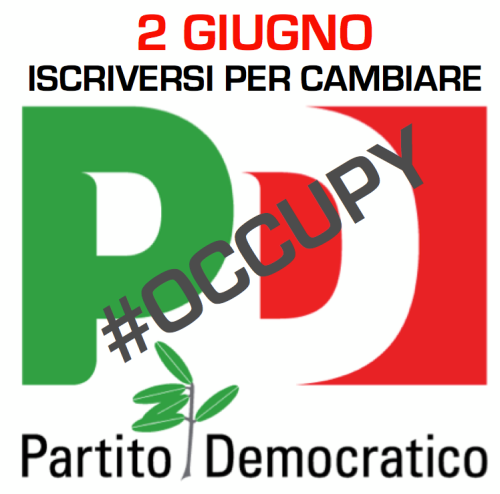 La politica italiana è ridotta da anni a mera politics. Non vi è alcuna traccia di policies. I programmi politici sono inesistenti. Nessun partito riesce a dire come e da dove vuole prendere risorse per portare avanti quelle generiche e stringate promesse elettorali. E l’informazione non riesce mai a fare quella benedetta “seconda domanda” che dovrebbe inchiodare i politici.
La politica italiana è ridotta da anni a mera politics. Non vi è alcuna traccia di policies. I programmi politici sono inesistenti. Nessun partito riesce a dire come e da dove vuole prendere risorse per portare avanti quelle generiche e stringate promesse elettorali. E l’informazione non riesce mai a fare quella benedetta “seconda domanda” che dovrebbe inchiodare i politici.
Si discute solo di posizionamento politico, di alleanze, di cariche e nomine. I dirigenti discutono la linea politica da intraprendere in funzione a ciò che fanno gli altri partiti. Inevitabilmente ci si sposta tutti sempre più verso il centro, cercando di diventare quel “partito pigliatutto” in grado di proiettare su di sé la maggioranza dell’elettorato italiano.
E’ così che ragionano all’interno della dirigenza del PD (e anche qualche leader emergente). Se passiamo una linea più centrista, pensano i dirigenti, riusciremo a pescare nella gran parte del bacino moderato, anche quello più conservatore, tradizionalmente di destra. Ma questo è un ragionamento ormai lontanissimo dalla realtà italiana. La grande vittoria del M5S ha dimostrato che ormai gran parte dell’elettorato non è più affezionato alle vecchie nomenklature dei vari partiti e partitini di Sinistra e di Destra. Ma la gran parte del quadro dirigenziale del PD non si è accorto di questo cambiamento e si è affossato da solo durante l’elezione del Presidente della Repubblica, proprio a causa di quei vecchi veti incrociati di varie correnti che gli elettori vedono oggi come l’ennesima dimostrazione dell’autoconservazione della politica, ormai rinchiusa nella politica di palazzo.
Il conseguente governo con B. (che tanto sa di “inciucio”, termine che utilizzo con parsimonia) è la testimonianza di questa paura di cambiare e di seguire i propri valori. Meglio fare un governo con B e spostarsi un po’ più al centro che tentare un governo con il M5S (che comunque sia, non è un partito di Sinistra). Come si può pensare che dopo tutti questi anni l’elettorato di Sinistra possa digerire un governo a braccetto con B.? Mentre B. organizza manifestazioni contro istituzioni dello Stato e manda sui propri canali Ruby a farsi difendere dalle accuse di prostituzione minorile, cosa fa Letta? Si cuce necessariamente la bocca. Uno, perché sa che le sorti del governo dipendono da B. Due, perché non ha più un briciolo di legittimazione per poter contestare le sue azioni. Sartori ha pienamente ragione, B. ha preparato il “trappolone” perfetto.
La Sinistra, invece, deve recuperare la propria visione e sviluppare il proprio orizzonte attorno al suo programma e ai suoi valori. Ma i Dirigenti PD vedono un programma progressista come necessariamente minoritario, non in grado di raggiungere la maggioranza degli italiani. La miopia non ha permesso ai dirigenti di carpire quanto sia cambiata la società italiana. Lo scollamento tra la società civile che vuole cambiamento e la politica che ragiona ancora secondo schemi da Prima Repubblica rappresenta il bivio a cui è arrivato il PD. O si cambia o si muore. O si dà voce alla base, al gruppo dei Giovani Democratici e a Occupy PD, o il partito non sarà che un contenitore vuoto.
Il PD deve rinascere e avere un’anima laica e progressista. Il tatticismo all’insegna del riposizionamento verso un centro vuoto, immobilista, conservatore, solo per cercare di sfruttare questa “rendita da posizionamento” è una logica sciocca e, se deciderà di prendere questa strada, il PD continuerà a non rappresentare alcuna forza di cambiamento e innovazione nell’orizzonte politico italiano.
